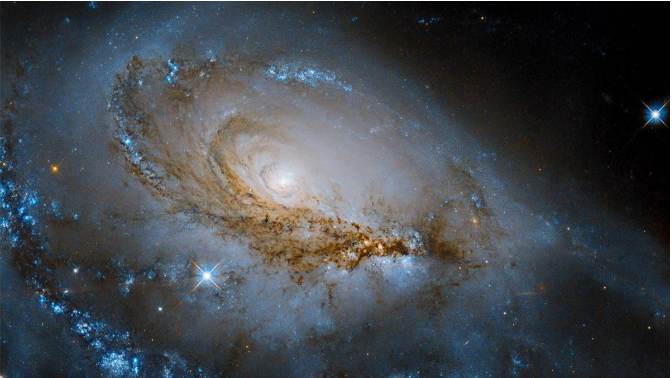
The spiral galaxy known as NGC 1961 has been beautifully captured by NASA’s Hubble Space Telescope. From the galaxy, they are young, brilliant stars that make up this object.
According to studies, NGC 1961 is located in the constellation Camelopardalis about 180 million light-years from Earth. It has been characterized as both an active galactic nucleus and an intermediate spiral galaxy. There are transitional spiral galaxies between “barred” and “unbarred” spiral galaxies, according to a number of findings. They lack proper stars of any type.
It should be observed that at certain wavelengths, the active galactic nucleus galaxies’ cores are noticeably brighter than the rest of the galaxy. There is a strong probability that NGC 1961 has a supermassive black hole at its center, which would eliminate the galaxy’s wind, while bright jets give it its distinctive appearance.
NASA Had Previously Revealed a Picture of NGC 1961
With the aid of information from both Chandra and the Hubble X-ray telescope, NASA of the US had previously revealed a picture of a supernova remnant. The government claims that in order to rewind the star’s explosion, scientists used data from the Hubble, Chandra, and Spitzer Space Telescopes. During this process, they learned about the star’s surroundings immediately prior to the explosion and the manner in which a stellar explosion occurred long ago.
The “Phantom Galaxy,” also known as M74, was captured by the James Webb Telescope and revealed by NASA this month. In the spiral arms of the galaxy, the image revealed fine threads of gas and dust. The nuclear star cluster could also clearly be seen due to the lack of gas.
A recent image from the telescope that portrays two galaxies colliding was published by NASA. The names of these two galaxies are SDSS J115 and LEDA 2073461. Even though these two galaxies are incredibly close to one another, they do not interact. Earlier, the image was posted to the telescope’s Twitter account. NASA claims that the two galaxies resemble ships traveling over the night sky.
According to NASA officials, recent Hubble observations indicate that NGC 1961 is a common form of Active Galactic Nucleus (AGN) that releases low-energy charged particles.
See all the latest news from Greece and the world at Greekreporter.com. Contact our newsroom to report an update or send your story, photos and videos. Follow GR on Google News and subscribe here to our daily email!



